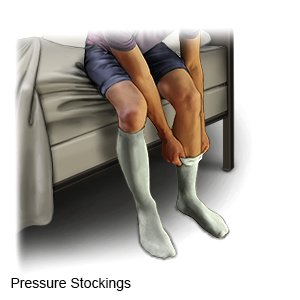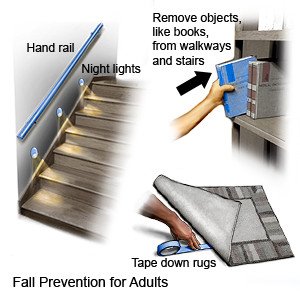Total Knee Replacement
Medically reviewed by Drugs.com. Last updated on Sep 23, 2025.
TKR, or knee arthroplasty, is surgery to replace all or part of your knee joint.
DISCHARGE INSTRUCTIONS:
Call your local emergency number (911 in the US) or have someone call if:
- You feel lightheaded, short of breath, and have chest pain.
- You cough up blood.
Seek care immediately if:
- Your leg feels warm, tender, and painful. It may look swollen and red.
- You cannot walk or move your knee.
- Your incision comes apart.
Call your doctor or surgeon if:
- You have a fever or chills.
- Your incision area is red, swollen, or draining pus.
- Blood soaks through your bandage.
- You have trouble moving or bending your knee.
- You have new knee pain or pain that does not get better with medicine.
- You have questions or concerns about your condition or care.
Medicines:
You may need any of the following:
- Acetaminophen decreases pain and fever. It is available without a doctor's order. Ask how much to take and how often to take it. Follow directions. Read the labels of all other medicines you are using to see if they also contain acetaminophen, or ask your doctor or pharmacist. Acetaminophen can cause liver damage if not taken correctly.
- NSAIDs , such as ibuprofen, help decrease swelling, pain, and fever. NSAIDs can cause stomach bleeding or kidney problems in certain people. If you take blood thinner medicine, always ask your healthcare provider if NSAIDs are safe for you. Always read the medicine label and follow directions.
- Prescription pain medicine may be given. Ask your healthcare provider how to take this medicine safely. Some prescription pain medicines contain acetaminophen. Do not take other medicines that contain acetaminophen without talking to your healthcare provider. Too much acetaminophen may cause liver damage. Prescription pain medicine may cause constipation. Ask your healthcare provider how to prevent or treat constipation.
- Blood thinners help prevent blood clots. Clots can cause strokes, heart attacks, and death. Many types of blood thinners are available. Your healthcare provider will give you specific instructions for the type you are given. The following are general safety guidelines to follow while you are taking a blood thinner:
- Watch for bleeding and bruising. Watch for bleeding from your gums or nose. Watch for blood in your urine and bowel movements. Use a soft washcloth on your skin, and a soft toothbrush to brush your teeth. This can keep your skin and gums from bleeding. If you shave, use an electric shaver. Do not play contact sports.
- Tell your dentist and other healthcare providers that you take a blood thinner. Wear a bracelet or necklace that says you take this medicine.
- Do not start or stop any other medicines or supplements unless your healthcare provider tells you to. Many medicines and supplements cannot be used with blood thinners.
- Take your blood thinner exactly as prescribed by your healthcare provider. Do not skip a dose or take less than prescribed. Tell your provider right away if you forget to take your blood thinner, or if you take too much.
- Take your medicine as directed. Contact your healthcare provider if you think your medicine is not helping or if you have side effects. Tell your provider if you are allergic to any medicine. Keep a list of the medicines, vitamins, and herbs you take. Include the amounts, and when and why you take them. Bring the list or the pill bottles to follow-up visits. Carry your medicine list with you in case of an emergency.
Related medications
Care for the area as directed:
You may have stitches or staples. These may be removed in about 2 weeks. Do not get the area wet until it is completely healed. Ask your healthcare provider when it is okay to get the area wet. Change your bandage as directed and if it gets wet or dirty.
Self-care:
- Apply ice on your knee for 15 to 20 minutes every hour or as directed. Use an ice pack, or put crushed ice in a plastic bag. Cover the bag with a towel. Ice helps prevent tissue damage and decreases swelling and pain.
- Go to physical or occupational therapy. A physical therapist will teach you exercises to build muscle strength and decrease pain and swelling. An occupational therapist will show you how to do daily activities safely. The therapist may recommend assistive devices to help you dress, bathe, and pick up objects. The assistive devices will help you prevent knee damage from twisting or bending.
Prevent blood clots:
- Wear pressure stockings as directed. Pressure stockings help keep blood from pooling in your leg veins. Your provider can prescribe stockings that are right for you. Do not buy over-the-counter pressure stockings unless your provider says it is okay. They may not fit correctly or may have elastic that cuts off your circulation. Ask your provider when to start wearing pressure stockings and how long to wear them each day.

Activity guidelines:
- Use assistive devices as directed. Your thigh muscles will be weak after surgery. Assistive devices will help you not fall.
- Go up the stairs by placing your non-operated leg on the step first. Then bring your operated leg to the same step. Repeat.
- Go downstairs by placing your operated leg down on the step first. Then bring your non-operated leg to the same step. Repeat.
- Do light housekeeping only. Ask your healthcare provider which housekeeping activities are okay for you. Do not vacuum, change sheets on a bed, or anything that makes you reach up, bend, or twist.
- Do not drive for at least 6 weeks or until your healthcare provider says it is okay.
- Do not play contact sports, tennis, golf, or ski until your healthcare provider says it is okay. These activities can loosen your knee implant.
Prevent falls:
 |
- Remove all loose carpets and cords. These can cause you to trip and fall.
- Use a shower bench or chair when you take a shower to limit the time you are standing.
- Use a toilet seat riser with arms if your toilet seat is low. A toilet seat riser will help prevent bending or twisting your knee.
Follow up with your doctor or surgeon as directed:
You may need to have your stitches or staples removed. Write down your questions so you remember to ask them during your visits.
© Copyright Merative 2025 Information is for End User's use only and may not be sold, redistributed or otherwise used for commercial purposes.
The above information is an educational aid only. It is not intended as medical advice for individual conditions or treatments. Talk to your doctor, nurse or pharmacist before following any medical regimen to see if it is safe and effective for you.
Further information
Always consult your healthcare provider to ensure the information displayed on this page applies to your personal circumstances.
